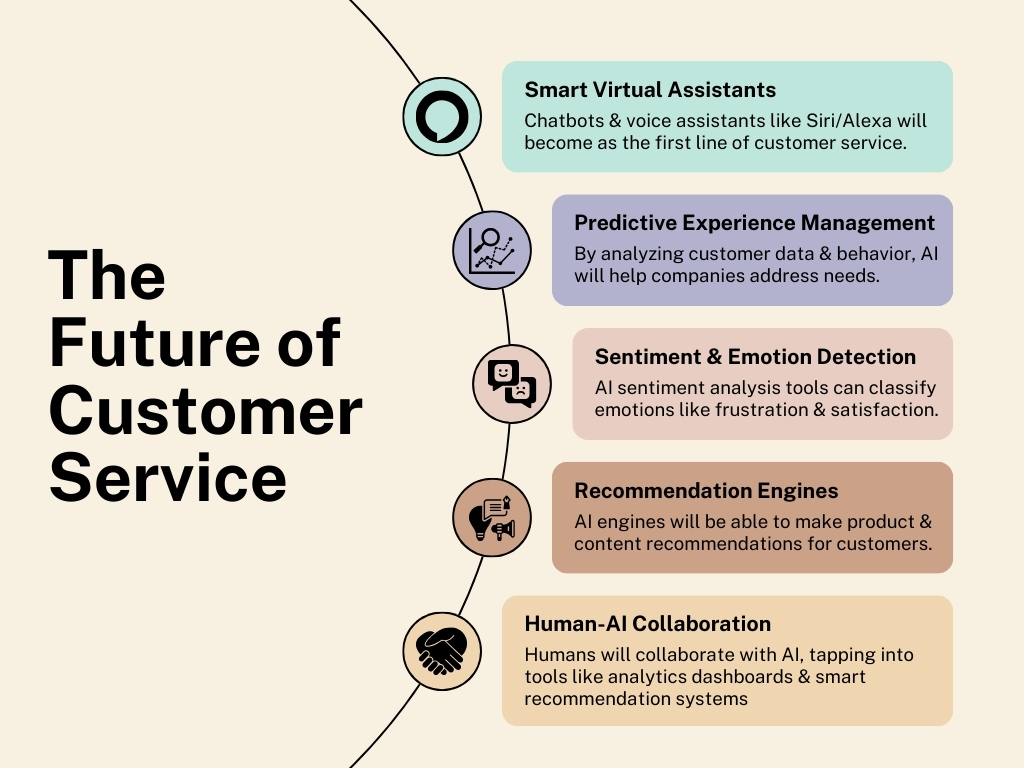Introduction
Customer service has undergone a dramatic evolution in the past few decades alongside rapid advancements in technology. How brands interact with and support customers has transformed from limited, business-centric transactions to always-on, personalized care centered around customer needs.
In the early days of commerce, customer service options were basic – walk into a local shop or office and wait your turn. Phone support eventually became ubiquitous as a channel, enabling access outside of business hours, but long hold times were common. Over time, new technologies have entered the fray – website forms, chatbots, live chat platforms, and eventually social media. Each stage aimed to enhance convenience and immediacy for the customer while serving more people at scale.
In this case study we go through the stages of customer service evolution while attempting to understand how customer service may look like in the future.
- Introduction
- The Evolution
- 1. In-Person Support: Long Wait Time and Limited Access
- 2. Phone Support: Increased Accessibility but Still Impersonal
- 3. Web Forms: Standardizing Repetitive Requests
- 4. Chatbots: Automating for Instant but Transactional Assistance
- 5. Live Chat: Real-Time Dialogue with Individuals
- 6. Social Media Customer Support: Personalized Public Interactions
- The Future of Customer Service
- Conclusion
The Evolution

1. In-Person Support: Long Wait Time and Limited Access
The traditional model of customer service involved walking into a business and quite literally waiting in line to be served, and the support was limited to office hours. Customers had to align their own availability around the convenience of the company.
The rise of sprawling shopping complexes brought multiple stores under one roof, but shoppers still often faced lengthy queues and uninspiring transactional interactions rather than helpful relationships.
2. Phone Support: Increased Accessibility but Still Impersonal
Call centers eventually emerged as a scalable solution for providing customer service outside of retail locations, enhancing accessibility with longer hours of operation. However, customers were still beholden to business hours, waiting through lengthy hold times, and dealing with agents reading from scripts rather than tailored conversations.
Human touch points were present via phone support representatives, but exchanges were often impersonal.
3. Web Forms: Standardizing Repetitive Requests
As the Internet took off, web forms emerged as a way to field common customer requests, questions, and complaints. Predefined submission templates and drop-down menus aimed to standardize queries and self-serve needs around popular topics like shipping, returns, and account changes.
However, submitting a form meant opening and monitoring your email inbox for a response. Replies were impersonal, prioritizing volume over relationships.
4. Chatbots: Automating for Instant but Transactional Assistance
The pursuit of providing instantaneous customer service at all hours motivated brands to develop chatbots – AI-powered robots that could respond to common customer inquiries without human involvement. Chatbots excel at addressing repetitive questions and simple transactions.
However, they fall short when conversations require contextual understanding or emotional intelligence. The automation enables lightning-fast interactions but in a robotic rather than relational way.
5. Live Chat: Real-Time Dialogue with Individuals
To facilitate real-time dialogues, many companies incorporated live chat features on their websites. This enabled back-and-forth conversations with agents via messaging in real time rather than submitting inquiries into a void and awaiting email replies.
However, much like call center systems, live chat platforms route conversations to the next available representative, making continuity challenging. Customers still lacked direct relationships and rapport.
6. Social Media Customer Support: Personalized Public Interactions
Finally, social media emerged as a customer service channel that could provide personalized, transparent interactions in a public format. Platforms like Twitter and Facebook enabled brands and customers to hold public conversations that humanized companies rather than locking dialogues behind phones and email.
Direct messaging also gives customers access to specific agents who can serve as familiar points of contact. However, social media requires dedicated staffing and skill sets – not simply routing queries but engaging in relationship-building.
The Future of Customer Service
Modern customers expect service that is instant, omnichannel, and anchored in relationships rather than transactions. It is reasonable to assume that companies will continue incorporating technology like AI chatbots for their efficiency but also aim for intuitive handoffs to live staff who can provide compassion and emotional intelligence. The priority will be understanding the individual customer journey rather than solely solving issues. Customer service both pre- and post-purchase will be a key brand differentiator, driving long-term loyalty rather than just temporary satisfaction.
However, seeing the rapid development of AI technology, we can predict that AI will take a leading role in future customer support operations.
Here are some of the keyways AI will be leveraged to enhance customer experiences:

1. Smart Virtual Assistants
AI-powered chatbots and voice assistants like Siri or Alexa will become ubiquitous as the first line of customer service. They can handle common questions and simple transactions quickly and efficiently around the clock. Over time, capabilities like natural language processing (NLP) will make conversations more intuitive and useful.
2. Predictive Experience Management
By analyzing customer data and behaviors, AI will help companies get proactive about addressing needs. Machine learning algorithms can detect early signals that a customer may be at risk of churning or encounter issues like service outages. This will enable much more proactive customer care interactions versus waiting for issues.
3. Sentiment & Emotion Detection
Understanding how customers truly feel is crucial but challenging to scale. By scanning messages, social posts, and conversational transcripts, AI sentiment analysis tools can classify emotions like frustration and satisfaction. This transforms how companies monitor experiences and identify pain points. Such tools uses machine learning and natural language processing (NLP) to understand sentiments and emotions.
4. Recommendation Engines
Based on analysis like past purchase behavior or service interactions, AI engines will be able to make tailored product and content recommendations for individual customers, creating more personalized engagements at scale that feel relevant rather than random. Netflix is a perfect example in this regard, it takes into account the interests of the user and description of the movie to suggest recommendations.
5. Human-AI Collaboration
While AI handles repetitive tasks like information lookups and routine requests automatically, humans will collaborate with AI, tapping into tools like analytics dashboards and smart recommendation systems to have better informed conversations.
Conclusion
Ultimately, the primary need behind the evolution of customer service through various stages is to enable the serving of personalized needs of the customer conveniently, and forging direct relationships with the customer.
The future role of customer service will focus more heavily on relationship building and resolving complex issues. In the background, AI will make every touchpoint smarter, faster and more predictive – understanding customers’ unique contexts to serve them best amid evolving expectations.






